Seeing Impossible Bodies: Fascination as a Spatial Experience
Patricia Pringle
The focus of my study here is that of magical and transformative performances and entertainments from another era. My larger project is to identify their continued resonance today, most particularly in our experience of spatial pleasure.
Spatial experience is fascinating in the original sense of the word ?fascinate?, meaning to bewitch or enchant. Its connotations of delight and attraction are part of modern usage. I have argued elsewhere that a new sense of pleasure in the manipulation of space contributed to an explosion in popularity of magic as a theatrical entertainment in the 19 th century, and that this fascination with spatial transformation is still being worked through in the spatial disciplines of the 20/21st centuries. Artists and designers are still engaged in working formally through the spatial changes of the previous century. We are prepared today to feel ourselves stretched, opened, compressed, relaxed, shocked or moved emotionally by spatial experience. An empathy with space that is both imaginative and visceral has become a characteristic of modernity. We know space through our knowledge of our bodies, but since that knowledge is itself uncertain, space too is uncertain, subjective, and contingent.
I want to discuss these ideas further by speculating on possible inward sensations induced by three acclaimed magical entertainments from the decades between the 1890s and the 1920s, bringing my modern eye to each. I select this period as one that bridged the inarticulate spatial dreamings of the 19 th century and the popular acceptance of "space" as the explicit material of architecture in the 20th century (van de Ven, 1974).
Although the three entertainments would be seen today as belonging to separate categories of performance, they all contained enough "magic" to warrant their inclusion in the literature of stage magic at the time of their popularity. As I have suggested, the appeal of magic shows around the turn of the 19/20 th centuries has a parallel with the appeal of spatial illusion and ambiguity in the spatial disciplines of today. Both reveal the spatial fascinations of their period, and an underlying sense that body/space is shifty, elastic, and a suitably malleable material for play. In my reading of the three entertainments, which have in common that they presented impossible extensions and contractions of the body, I suggest that the shifts and extensions of the performing bodies called up echoes within the bodies of their audiences that were part of the pleasurable and thrilling sensations that they evoked. Although the routines might seem banal today, I contend that the shifts of perception that they called up in their audiences are at work today in many constructed spaces that are regarded as having qualities of spatial magic.
I will discuss the dance performances of Loie Fuller dating from the late 1890s; A Match for Anyone, a stage magician?s routine from 1915 that involved magical expansion; and the brief popularity of the Tanagra Theatre before the 1920s (a popular sideshow that created living miniatures). I discuss them from the assumption that the audience was also part of the work, their modes of seeing contributing to the total experience. The theories of perception that I draw on are speculative rather than conclusive, and range from the 19 th century models discussed above to popular concepts from the late 20 th century, such as the linking of the experiences of "immersion" and "flow" with the "peak experiences" achieved through movement, each involving neurological processes and brain chemistry, or the theories of the ?sensuous intellect? which link modes of seeing to larger spiritual beliefs.
Loie Fuller, the Fairy Electricity
Loie Fuller, a previously undistinguished American actress, noticed the effect of light on a gauzy silk skirt that she wore on stage. By watching herself in a mirror, she "reached a point where each movement of the body was expressed in the folds of the silk, in a play of colours and draperies that could be mathematically and systematically calculated" (Fuller, 1913:33-34). From these observations, she evolved a series of dances in which her body and robe became the projection screen for a variety of optical effects of her own invention, drawn from her interest in stage techniques, electrical lighting and the properties of materials. She arrived in Paris in 1892, secured an engagement at the Folies-Bergères, and became an immediate success; the usual audience at the Folies was "lost amid a crowd composed of scholars, painters, sculptors, writers and ambassadors". Within the year anything evocative of her act was named after her. Her success lasted: she led her own company until her death in 1923. The performances fascinated and influenced figures from the cultural avant-garde of many disciplines.
Her audience found her performances chaste, hypnotic and thrilling. But what did they see? Her outline flowed from one fluid form to another, its boundaries stretching and shrinking in ways which obliterated any sense of incongruity with her own less-than-slender fleshly form. An extended body emanated beyond her own, created by hundreds of metres of flowing silk, supported by wands attached to her arms and frames supported by her head-dresses:
The draperies [for the dance Lily] could be extended till they seemed to fill the space….the costume contained 500 yards of gossamer-thin silk and could radiate 10 feet from her body in every direction and be thrown up to the surprising height…. of 20 feet. It was close to 100 yards around the hem. (Sommer quoted in Banes, 1998:73)
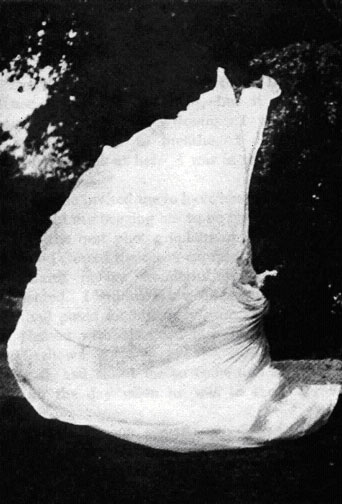
Figure 1 Loie Fuller performing the dance ?Lily? c. 1900. The photograph was taken out of doors rather than on stage
Source Loie Fuller, Fifteen Years of a Dancer?s Life
The manipulation of the fabric was part of Fuller?s choreography, and not a mere wafting and twirling as with the skirt dance which was popular at the same period. The rhythms of her silks, starting from her own movements, rippled and spiralled in patterns of internal harmonics whose generation she practised and perfected. Sometimes she and her dress became united as elemental spirits - water, fire, cloud, night, falling bits of sky - at other moments there would be a revelation of a human figure. The coloured lights projected onto her draperies were operated by an army of electricians who rehearsed like other members of her troupe. Her performances were conjured out of the darkness that was the backdrop and frame for her movements. I imagine the effects that she produced as having the two-and-a-half dimensionality of fireworks or flames. Interestingly, the poet Georges Rodenbach described her as a fresco (Kermode, 1962:6), and the devices which she invented would reinforce this alteration of depth by removing her from any recognisable framework which could give a consistent scale to her image, such as the arrangement of underlighting which she patented for producing "an illusion? of the person floating or dancing in air" (Rees & Wilmore, 1996:102). She provided the resonance for a new sort of spatial pleasure ? the extended body, the boundless body, the body-in-space, astral body; a weightless and powerful body, beyond gender, angelic. In later dances, the visible body scarcely counted, with the development of dances in which her troupe of dancers moved below a vast ocean of silk, others in which the travelling spotlight picked out only her hands.
To speculate about a visual response to Loie Fuller?s performance, I want first to compare it with an older routine which also involved shape changing, but in which attention, body and space formed a different conjunction. The routine known as Troublewit can be traced back in Europe to at least the 17 th century. The Troublewit is a long sheet of paper, specially folded and accordion pleated which the entertainer dexterously manipulates into an endless variety of shapes, origami-like, sometimes fitting it quickly to the body (eg hat, ruff, bonnet, cuff, wig, beard) and at other times forming a series of objects, all the while keeping up a patter filled with linking jokes and puns.
Photographs of Professor Hofzinser, a celebrated performer of the 1850s (Fischer, 1985), demonstrate the point of this routine; that the fun depended on the repeated alteration of the shape from one finished form to another, a series of perfect moments. The characteristic of Loie Fuller?s performance, in contrast, was its ebb and flow, always in the process of forming and dissolving, existing at what Deleuze, in writing of Bergson?s concept of the movement-image, has called "any-instant-whatever" (Deleuze, 1986:4). The comparison of these two very different moments speaks through their photographs, (which themselves convey a history of the photographic process) for Professor Hofzinser appears to hold himself still in order to allow the Troublewit to have its correct form, whereas Loie Fuller must be caught in movement to allow her extended garments to convey the image of the lily.
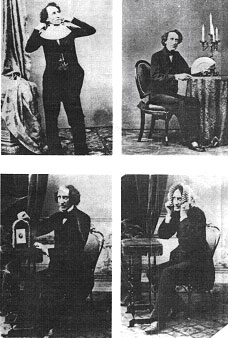
Figure 2 Professor Hofzinser and the Troublewit c.1850
Source Ottokar Fischer, The Magic of Johann Nepomuk Hofzinser
Photographs however are acknowledged to give an inadequate suggestion of Fuller?s act. The underlighting that she frequently used gave her audiences the impression of great height although she was quite short. Mallarmé?s observation that she "ecstatically stretched to the extremity of each wing" evokes the spatial disturbance we feel when a great bird unfolds its wings, a lateral expansion which far exceeds the empathetic reach of a human. Although the physical effort of controlling her vast draperies was exhausting for her, the impression made on her audience was not one of a human energy, rather the embodiment of raw powers such as wind, flame, storm, electricity. Reviewers and diarists, for whom an empathetic sense of bodily expansion and weightlessness had conjured up an ethereal being, frequently recounted the shock of seeing the "real" Loie after a performance - short, plump, damp, groaning with exhaustion (Current & Current, 1996:177).
Kermode?s comment, that the imagination of the spectator fed on her independently of what she intended (Kermode, 1962:21), is astute. She herself had no interest in the representative accuracy of the forms, whose names were given to the dances by the audience; her own interests were in light and the "truth" of motion (Fuller, 1913:66-72). Nonetheless, her moving forms left traces embedded in the memory for later expression into the numerous images which her work inspired, the imagination of the audience reading private emotional profundities into the play of form and light which she created. My own speculations continue the tradition.
The eye watching Loie Fuller would have had many opportunites spontaneously to experience something like the practice that Arthur Zajonc describes as a "yoga of the senses" (in Sewall, 1999:227). Through a process of engagement and disengagement with an object of visual contemplation, the afterimage, a "mood or gesture" begins to surface within one?s inner attention. The experience also involves finding the right rhythm or cadence for vision. The exercise, which Zajonc refers to Goethe?s methods and to the Buddhist practice of kasina, reminds me of the description of Rodin?s belief in working only from memory, for only when conjured up in memory did the works "acquire the necessary subjective coloration" (Fleming, 1994:399). Rodin wrote in tribute to Loie Fuller that his "artistic heart was grateful to her" (Fuller, 1913:127). This way of seeing is of its age and suggests the wider and deeper context which created Art Nouveau.
Mallarmé noted that such performances, rather than provoking the usual mania for looking, instead offer occasions for reflection - for insight, that is, rather than sight. He remarks that the opera glasses that provided ballet aficionados with private consumption of a dancer's images in fact blind the spectator to the dance's greater revelations. Despite the spectacular effect of Loie Fuller's dance? they invite what Mallarmé calls a "transparent prolongation" of the gaze through, rather than at, its subject? (McCarren, 1995)
"Looking through" suggests a visionary gaze, clairvoyant, seeing other possibilities, an expansive and extending gaze uniting eye and mind. Loie Fuller?s performances seem to have been able to stimulate the sort of seeing which is the "clear vision" of today?s proponents of the gaze "into" rather than "at" the world, such as environmental philosopher David Abram or visual ecologist Laura Sewall. The architect Antonio Gaudí too linked his spatial abilities to his ability to "see clearly", and attributed his personal modes of vision in part to the physical experience of seeing the landscape in which he spent his youth (Martinell, 1975).
For some this may form part of larger beliefs that link to their ethical and spiritual relationship to the world. None of these observations need force the unwilling into mystical territory, however, as they can all be seen as examples of reconciliations between older scientific models and newer disciplines such as kinesiology, chiropractic, etc. To change the way of seeing is to change the posture and use of the body, for visual function is linked to the elasticity of the eye. It is a commonplace that vision is blurred after prolonged use of the eyes in a close focal plane. People report clearer vision after spending time in situations where their eyes rest on distant horizons. By a similar mechanism, others report clearer vision (in both senses) after meditation, massage and other body therapies that induce relaxation in the eye.1
Such relaxation of the ciliary eye muscles, which occurs naturally when looking into the distance, is frequently associated with design devices which support a meditative, insightful and disembodied gaze by suppressing cues for reading depth, such as by erasing the lines where wall meets ceiling or making surfaces ambiguous by treating them in ways which render them luminous, refulgent, waxy or chalky. Such devices, characteristic of Fuller?s stage inventions, can be seen in the work of architects Tadao Ando or Luis Barragán, whose works are often cited as examples of 20 th century "sacred" spaces.
Fuller?s use of darkness as a container for light would also activate other physiological aspects of vision. Darkness flattens space and at the same time stirs the desire to reach out with other senses than sight. James Turrell?s explanation of those of his works which start from darkness ? "Low light opens the pupil and then feeling comes out of the eye as touch, a sensuous act" (Turrell quoted in Lynn, 2001:53) - is one which might raise the hackles of an ophthalmologist but which again acknowledges the sensory act of the viewer as a part of the work and is in sympathy with the ideas of a host of others stretching back over the centuries who have espoused theories of a reciprocal engagement with the world in an explanation of the visual process (Sewall, 1999:39).
A Match for Anyone
Enough of this dream state! My second entertainment for visual speculation is very different. It is a short conjuring routine, constructed around the use of an "expanding box", a staple of stage magic. This English routine dates from 1915, a date whose significance will become clear:
The performer [places] an ordinary, unprepared matchbox in the centre of a large table, which preferably has been used for some other effect. Producing, magically or otherwise, a flag 2 feet square, he momentarily covers the matchbox, after which it is seen to have increased to about 18 inches high. The flag then in his hands also increases to 7 or 8 feet, and wide in proportion, mounted on a flagstaff. Jumping on the table, he holds the flag up for a moment so as to once more cover the matchbox, which when the flag is lowered is found to have increased in size to something like 6 feet high. Dropping the flag on the table for moment he walks round the box and sounds it, indicating that it is a solid box, not a mere frame covered with fabric or anything of that nature. Jumping down from the table and again picking up the flag, he announces that he will now produce a ‘Match for Anyone.’ The match box opens and a fine specimen of British fighting man comes forth… (Sharpe, 1992:38)
(ie. a soldier in smart military uniform who marches off to a burst of stirring martial music and the cheers and applause of the audience.)
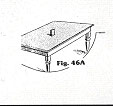
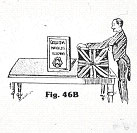
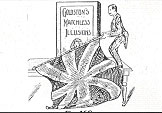
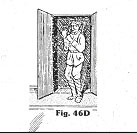
Figure 3 ?A Match for Anyone?
Designed by A.S.Cubitt, 1915
Source Sam Sharpe, Conjurors Mechanical Secrets, p38
The apparatus is built into the tabletop. The final box unfolds itself and springs up when the performer jumps on the table, brandishing the giant flag to conceal the action. The magic methods for producing and expanding the flag, introducing a living soldier into a box in mid-air etc, are worked in "the usual ways". (And no, the soldier does not start in the tabletop as well.)
Naturally the trick, well done, would not reveal its mechanisms. The audience would see and hear a rhythmic sequence of repeated events reinforced by repetitions of gesture. Sensations would be produced through the visual surprise, anticipation and delight of the successive jumps in scale, and through the brisk gestures of the performer and the apparatus, accompanied by sharp sounds ? double knocks, rat-a-tats and finally the military march. Heart and eye leap simultaneously, there is no introspection here. The routine and apparatus are in the tradition of the cheerful communal spectacle of pantomime with its instantaneous transformation scenes like the "either/or" changes of Troublewit, in contrast to the subjective, insight-provoking "neither/nor" of Fuller?s work.
The historian William McNeill has speculated on the effects of the human emotional response to rhythmic movement (McNeill, 1995). Curious about the unexpected sense of personal well-being that military drill induced in him ("a strange sense of personal enlargement; a sort of swelling out, becoming bigger than life?.[an] odd, surprising, and apparently visceral response") (ibid.:2-3), he set out to find whether scientific investigations had been undertaken of such responses. The scholarly studies that McNeill researched seemed merely to sketch a possibility of paths of emotional excitement in the sympathetic and para-sympathetic nervous systems involving the production of endorphins. Recent popular science has been readier to speculate about the processes: the sense of wellbeing and enhanced personal potential which he describes is often described in the literature suggesting links between mental health and exercise (Clarke & Humberstone, 1997:88-89). McNeill?s particular interest is in the sense of collectivity which he feels is inspired in a group who are simultaneously experiencing the pleasurable effects of rhythmic movement and he goes on to build his argument around this. However, McNeill notes that the seat of bodily response to rhythmic movement is situated far away from our verbal capacities, centring instead in "those parts of the nervous system that function subconsciously, maintaining rhythmic heartbeat, digestive peristalsis, and breathing, as well as all the other chemical and physiological balances required for the maintenance of ordinary bodily functions" (McNeill, 1995:6).
The interplay of physical movement, rhythmic spatial experience and mental life is of course at play in such meditative spaces as cloisters, which work to calm the mind through quieting the body?s motions. The inverse also happens, a different sort of rhythm induced by shock and movement being used to excite the physical senses and heighten a sense of unity and conviviality.
I wonder if some of the laughter and delight of A Match for Anyone lay in its enforcement of participation in a shared visual rhythm? As our eyes urge us to leap, quantum-like, through states of small, medium and large in sympathy with the matchbox, do we share in the exhilaration of performing our own collective mini-drill? The mismatch between the physical rhythm and the verbal jolt of the pun could also force the hypnotising "re-orientation response" which is ascribed to sudden shifts and disruptions in the modes of attention.
But as Bergson, and later Adolphe Appia attested, certain rhythms force us to join in, telling us "You are the work of art." Appia was convinced that to incorporate sound and rhythm into the organism was the first step towards the living work of art (Bablet, 1982:55). Ideas about rhythm, the feeling for space, theories of empathy, and parallels between the relation of body to architecture and psyche to gesture, abound in the literature of the development of theatrical design between the 1890s and 1930s (Fuerst & Hume, 1929). They develop the links between imaginative and physical experience which had been postulated in the aesthetic theories of previous decades. Whereas Vischer (1876) had proposed an empathetic reaction to form taking place in the imagination, a projection of the human self into the thing attended to, Wölfflin (1886:155) in addition brought into play the idea of an actual muscular sensation being evoked: "Instead of an inexplicable ?self-projection?, we might perhaps imagine that the optic nerve impulse directly stimulates the motor nerves, which cause specific muscles to contract".
Similar ideas were developing in the various forms of body-work that date from the turn of the century. The link between mind and muscle (that to think of an action is to cause a slight contraction in the muscles which would actually produce the contraction in reality) has gradually moved from the realm of speculation to mainstream studies of the science of behaviour, once it became possible to demonstrate it with medical apparatus (Barlow, 1975). Rhythmic visual and bodily movements are today linked in educational kinesiology, whereby eye-movements, energy flows and neural patterns are considered to be beneficially re-aligned.
Ideas of empathetic embodiment and joyful unity with the world through rhythmic vision underlie the methods of "active seeing" which continue traditions from the 19 th century. One such technique is described in The Active Eye in Architecture, a 1970s manifestation of an "alternative" approach to giving attention to the world that is intended to teach a layperson to perceive through the body those forces and rhythms that are expressed in great architectural compositions (Trevelyan, 1977).
Seeking to explain in popular terms the role of sight in locking the senses together and influencing both touch and hearing, Aristide Fournet, an optician, wrote in 1889:
The senses love to be together. The extra nerve required to walk along a road in the dark is the dragging of [the] senses that are not used. If you were to throw light, colour, music, and a glass of sherry on the scene, our subject would be much comforted no doubt. (1889:143)
The pleasurable excitement felt when submitting to an almost choreographed vision that engages both visual and bodily senses is demonstrated by the popularity of retail projects that utilise it. One example is the recent use of lenticular film in the windows of a New York store, which forces the passer-by into a mini-dance: "People can?t resist another pass to observe the mutation" (Gould, 1998:124).
The Tanagra Theatre
My final entertainment worked on the senses in yet another way. It shocked the senses by miniaturising the body. It introduces two sets of thoughts, one concerning visceral responses to the miniature in itself and the other concerning responses to the prospect of other simultaneous realities, with the oscillation of "both/and" in contrast to "either/or" and "neither/nor".
Tanagra Theatres existed in many European cities in the years 1910-1920 (Viefhaus-Mildenberger, 1961:27-30). The name comes from the figures excavated at Tanagra in the 1890s whose name became synonymous with perfect living miniatures, particularly female. The sideshow illusion consisted of a miniature stage where living actors appeared as real but tiny figures, through an arrangement of plain and concave mirrors. Its development as a sideshow attraction came about as a by-product of research into optical instruments which could better sustain the perception of depth (von Rohr, 1920). The use of concave mirrors has a long history in magic but for the Tanagra the stronger light of electricity was essential.
The wistful attraction of a view into a living miniature world can be felt elsewhere in the period. The English particularly clung to it. J.M. Barrie?s Tinker Bell, with her perfect tiny home set into Peter?s wall, seems to have satisfied an adult fancy as much as a childlike one in its day (Peter Pan was first staged in 1904). Angela Carter notes that Walter de la Mare?s Memoirs of a Midget (1921) whose tiny heroine lived estranged from a world that could not connect with her emotionally, elicited a "cabinet full" of teeny-tiny gifts from his readers (Carter in de la Mare, 1982:ix).
Ralph Rugoff links attention to the miniature to bodily experience:
Tiny artworks force us to draw closer…and this forward movement parallels a mental process; the more closely we examine minute details, the less we notice the gulf in size that separates us. The act of paying attention is in itself a kind of magnifying glass….this charges our experience of the object, imbuing it with an almost hallucinatory acuity [my italics]….Despite the negligible physicality of tiny work, its effect on us may be surprisingly visceral. (Rugoff:14-15)
Indeed, the physical sensation of a sharpening of vision can be evoked merely by visualizing a miniature object with the mind?s eye.
We can know the miniature only in relation to ourselves. Susan Stewart comments (noting that there are no miniatures in nature):
The miniature assumes an anthropomorphic context from the outset….The miniature historically has emphasised a particular configuration of subjectivity: first-person experience; single-point perspective; spatial extension from the individual perceiving viewer; interiority or domesticity in opposition to the public or social sphere of the monumental; the diminutive, the child-like, the pastoral, and the picturesque as ‘alternative’ or ‘alienated’ views. (Stewart:2)
The alternative view that the miniature suggests for Stewart leads me to the final viscerality of seeing that I will consider here: the bodily and mental excitement inspired by the vision of the (im)possible. It involves an anecdote:
The architect and designer Frederick Kiesler incorporated a "tanagra device" in a stage setting for Karel Capek?s utopian drama, R.U.R., staged first in Vienna and then in Berlin (1922/23).
‘This R.U.R. play was my occasion to use for the first time in a theatre a motion picture [a small cinema projection was also incorporated in the set] instead of a painted backdrop, and also television2 in the sense that I had a big, square panel window in the middle of the stage drop which could be opened by remote control. When the director of the human factory in the play pushed a button at his desk, the panel opened and the audience saw two human beings ….a foot-and-a-half tall, casually moving and talking, heard through a hidden loudspeaker. It was quite an illusion, because a minute later you saw the same actors appear on stage full size. There was, inevitably, a burst of applause at this moment….I mention it because these new devices to present the interplay of reality and illusion brought many artists to the theatre.
After the second performance…a man pushed his way in [through the stage door]….It was van Doesberg. He … asked, “Where is Kiesler?”.…He made a sign, as you do when you call your gang, you know. The gang came in and the gang was Kurt Schwitters, Hans Richter, Moholy-Nagy, El Lissitsky, Werner Graeff and Theo van Doesberg. They...grabbed me without saying a word, lifted me up and took me 6 or 7 blocks to a club where we met Mies van der Rohe and spent the whole night talking about architecture and the future theatre…it seemed to each of us as though we were individuals who had known each other for a long, long time. And this is how I joined the group known as “De Stijl”….’
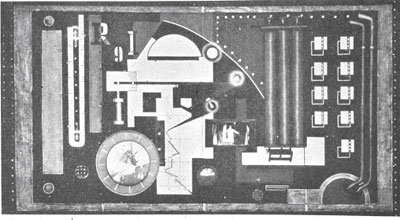
Figure 4 Stage set by Frederick Kiesler incorporating a tanagra device, 1923
The tanagra image is visible in the rectangular box just right of centre
Source 20th Century Stage Decoration
The story is delightful, but it has one flaw. The Tanagra set-up permits only a very controlled angle of viewing, hence its restriction to a sideshow context. In a theatre it would surely have been impossible for much of the audience to see the tiny figures. Could the burst of applause have been excited by the desire for the visualisation of ?modern? space/time by eyes which, as Kierkegaard wishes, ?forever young and ardent, see the possible??
The examples that this suggests in the history of 20 th century design are countless ? consider the 1930?s giving of streamlined forms to static domestic objects, or today?s incorporation of ?information technology? of limited functionality into just about any context. The purpose they served when they were originally felt as thrilling was surely a psychic one, of connecting us to an imagined and more vital world.
We are linked to our times not only by the ability, but also the desire, to see in particular ways. Attention, vision, and spatial perceptions have their own history. ?Theory? and ?speculation?, ?theatre? and ?show? (all rooted in seeing) link performance, experience and the possibility of choosing how we will see.
References
Bablet, D. (ed.) (1982) Adolphe Appia, 1862 ?1928, Arts Council of Sweden
Banes, S. (1998) Dancing Women: Female Bodies on Stage, Routledge: London
Barlow, W. (1975) The Alexander Principle, Arrow Books Ltd
Clarke, G. & B. Humberstone (eds) (1997), Researching Women and Sport, Macmillan: London
Current, R.N. & M. E. Current (1997) Loie Fuller, Goddess of Light, Northeastern University Press: Boston
de la Mare, W. (1982) Memoirs of a Midget, preface by Angela Carter, Oxford University Press
Deleuze, G. (1986) Cinema 1: the Movement Image, trans. Hugh Tomlinson & Barbara Habberjam, Athlone: London
Fischer, O. (1985) The Magic of Johann Nepomuk Hofzinser, trans. Richard Hatch, Walter B. Graham, Modern Litho: Omaha
Fleming, W. (1994) Arts & Ideas, Thompson Learning: New York
Fournet, A. (1889) The Philosophy of Sight: Is Bad Sight on the Increase? Swan Sonnenschein: London
Fuerst, W.R. & S. J. Hume (1929) 20 th Century Stage Decoration, Alfred A. Knopf
Fuller, L. (1913) Fifteen Years of a Dancer?s Life, a republication by Dance Horizons: New York, no date, of the 1913 original
Goodrich, J. (1966) Natural Vision Improvement, Penguin Books: Ringwood
Gould, K. (1998) "Veiled illusions" [Issey Miyake Pleats Please store, New York City: Toshiko Mori Architects], Architecture, 87,9, Sept, p.124
Kermode, F. (1962) "Loie Fuller and the Dance Before Diaghelev", Theatre Arts, 46, 9, p. 6
Kiesler, F., interview, Progressive Architecture, XLII, July 1961, p. 109
Lynn, V. (ed.) (2001) Space Odysseys: Sensation & Immersion, Art Gallery of NSW: Sydney
McCarren, F. (1995) "The 'Symptomatic Act' Circa 1900: Hysteria, Hypnosis, Electricity, Dance", Journal of Critical Inquiry, 21, 4,www.uchicago.edu/research/jnl-crit-inq/v21/v21n4.mccarren.html
McNeill, W. (1995) Keeping Together in Time, Harvard University Press: Cambridge, Mass
Martinell, C. (1975) Gaudí : His Life, His Theories, His Work, trans. Judith Rohrer ; ed. George Collins, Editorial Blume: Barcelona
Rees, T. & D. Wilmore (eds) (1996) British Theatrical Patents 1801-1900, The Society for Theatre Research: London
Rugoff, R., catalogue essay in At the Threshold of the Visible, Independent Curators Inc: N.Y. p. 14, 15
Sewall, L. (1999) Sight and Sensibility: the Ecopsychology of Perception, J.P. Tarcher/Putnam: New York
Sharpe, S. (1992) Conjurors? Mechanical Secrets, Tannen's Magic Manuscripts: London
Stewart, S., catalogue essay, At the Threshold of the Visible, Independent Curators Inc: N.Y. p.2
Trevelyan, G. (1977) The Active Eye in Architecture, Wrekin Press
van de Ven, C. (1974) Concerning the Idea of Space, The Rise of a New Fundamental in German Architectural Theory and in the Modern Movements until 1930, PhD Dissertation, University of Pennsylvania
von Rohr, M. (1920) Die Binokularen Instrumente, Springer: Berlin
Viefhaus-Mildenberger, M. (1961) Film und Projektion auf der Bühne, Emsdetten
Wölfflin, H. (1886) "Prolegomena to a Psychology of Architecture", in Empathy, Form and Space, p 155
Notes
1 See for example, Janet Goodrich,Natural Vision Improvement, Ringwood: Penguin Books, 1966. Goodrich teaches visual exercises, developed out of the Bates Method, which promise to sustain the flexibility of the eye and develop visual acuity. They incorporate many ideas from ?holistic? theories of the body, which have a resonance with some of the theories of empathy within physiological processes which are touched on in this essay. Mainstream opticians reject the Bates/Goodrich model of vision but agree that the physical, if not the mental, exercises are healthy for the eyes.
2 It was only television in the sense of suggesting control over remote spaces. No screen is involved in a Tanagra, the images are viewed in a concave mirror.